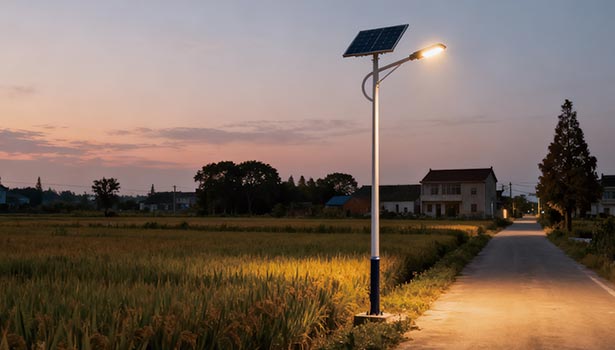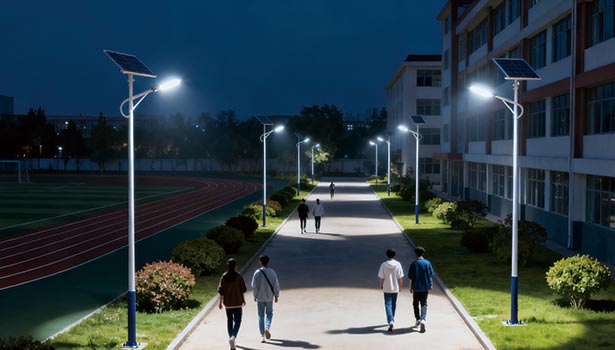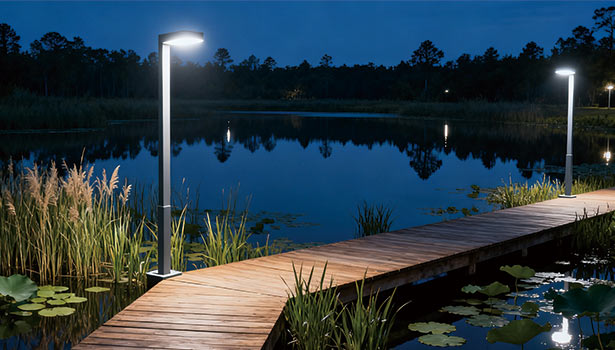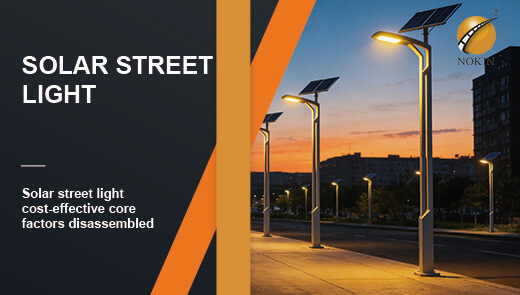Why Are Solar Street Lights More Expensive Than LED Street Lights?
In municipal construction, rural renovation, or scenic area lighting projects, purchasers often face a dilemma: despite being similar lighting equipment, solar street lights are frequently priced higher than conventional LED street lights. Both tout “energy efficiency” as their core advantage, so why the price premium? Is it merely cumulative costs, or does solar lighting offer irreplaceable value beyond conventional LEDs? This article comprehensively analyzes the reasons behind solar street light pricing across six dimensions: cost structure, performance design, safety assurance, long-term value, rural adaptability, and procurement recommendations. It also provides practical guidance to help you make a more informed choice.

Street light Costs
The most direct reason solar street lights cost more than standard LED street lights is their more complex cost structure. While standard LED street lights simply “light up when powered,” solar street lights require a complete energy conversion and storage system to achieve “off-grid, independent operation.” The cost of each core component contributes to the final price.
Standard LED street lights: Simple Components, Low-Cost Foundation
The core components of standard LED street lights are highly simplified, primarily consisting of three types: LED bulbs, basic control circuits, and grid connection cables. LED bulbs utilize standardized mass-produced products, featuring mature technology and low costs. The basic control circuit only needs to implement “light switching” and simple overload protection, featuring a straightforward design. Grid connection cables use conventional wires without requiring special protection. These components rely on mass production, resulting in low per-unit costs. Installation requires no complex debugging, further reducing overall investment.
Solar Street Lights: Multi-Component Synergy, Inevitably High Costs
Solar street lights require five core components to form an “energy closed loop,” each with strict performance requirements. Solar panels account for 30%-40% of the total cost, energy storage batteries cost 2-3 times more than standard batteries, R&D expenses for smart controllers reach 20%, compatible LED light sources add 15%-20% to costs, and protective components increase expenses by an additional 10%-15%. The cumulative effect of these high-specification components makes the unit cost of solar street lights significantly higher than conventional LED street lights.
Using LED Bulbs
Many wonder: “Why are solar street lights more expensive if they also use LED bulbs?” The answer lies in “adaptability”—the LED bulbs in solar street lights require deep integration with the solar power system, rather than simply using standard off-the-shelf products. This customized design incurs additional costs.
Standard LED Street Light Bulbs: Standardized Selection, No Compatibility Pressure
Standard LED street light bulbs require no consideration of “power limitations.” Power is determined solely by road width and lighting needs, allowing direct procurement of universal models. They have low protection rating requirements (typically IP60), use ordinary casing materials, involve low production complexity, and offer controllable bulk procurement costs. Replacement requires no debugging—simply swap and use.

Solar Street Light LED Bulbs: Customized Design, High-Cost Adaptation
Solar street light LED bulbs must be designed around “energy efficiency + endurance.” Power output requires consideration of local daylight hours and battery capacity, with some models needing dimming support and integrated interlocking modules. Protection ratings must reach IP65 or higher, using weather-resistant materials with complex sealing processes. This customization increases R&D costs and reduces mass production scale due to parameter variations, resulting in a 20%-30% higher cost compared to standard models.
Safety in Use
During extreme weather like heavy rain or typhoons, or in complex outdoor environments, safety hazards in standard LED street lights are often overlooked. Solar street lights require additional investment in protective design solutions to achieve high safety standards, which is another key factor in their higher price.
Standard LED street lights: High-Voltage Power Supply with Persistent Safety Risks
Standard LED street lights rely on 220V high-voltage AC power. With wiring exposed outdoors long-term, aging or damaged circuits can leak electricity during heavy rains—a risk heightened by water accumulation on rural roads. Limited protective measures, such as basic leakage protection devices, fail to eliminate hazards. Adding safeguards later requires additional investment.
Solar Street Lights: Low Voltage + Multi-Layer Protection, Visible Safety Costs
Solar street lights operate on 12V/24V DC low voltage, eliminating electrical leakage risks at the source. Most models feature motion sensors to reduce circuit load. Core components are housed in sealed enclosures resistant to UV rays and corrosion, while controllers monitor circuit anomalies in real-time and automatically cut power. These designs require additional components, increasing costs by 20%-25% compared to standard LED street lights, but deliver superior safety assurance.
Eco-Friendly & Energy-Efficient
Long-term use reveals solar street lights' significant environmental and energy-saving advantages. However, realizing these benefits requires higher initial investment—essentially “front-loading long-term value”—which explains their higher price compared to standard LED street lights.
Standard LED street lights: Short-Term Energy Savings, Long-Term Energy Costs
While more energy-efficient than traditional sodium lamps, standard LED street lights still rely on grid power. Approximately 70% of China's grid electricity comes from coal-fired power generation, leading to indirect carbon emissions over time. Ongoing electricity expenses also persist, with potential future increases in electricity rates or environmental surcharges making long-term costs unpredictable. Additionally, the stability of energy sources faces challenges.
Solar Street Lights: Initial High Investment, Long-Term Zero Energy Costs
Solar street lights harness clean solar energy with zero pollutant emissions during operation, aligning with China's “dual carbon” policy. Once installed, they require no electricity payments, yielding substantial long-term savings that far exceed the initial additional investment. Subsidies in some rural areas further reduce upfront costs, while advancing technology drives annual cost reductions, making their economic advantages increasingly evident.

Why should rural areas use solar street lights?
As analyzed earlier, solar street lights' characteristics align perfectly with rural lighting needs, addressing practical challenges in rural areas and making them an ideal choice for rural upgrades. Their advantages manifest in three key areas.
Addressing grid challenges
Rural areas feature scattered settlements and weak grid infrastructure, with many remote roads lacking grid access. Installing conventional LED street lights incurs high costs for line laying and grid upgrades. Solar street lights eliminate grid dependency, bypassing these costs. Their initial investment is more advantageous, and they incur no ongoing electricity expenses.
Adapting to Rural Environments
Rural nighttime lighting demands are moderate. The “brightness adjustment feature” of solar street lights prevents energy waste. Their core components are sealed within protective casings, enabling adaptation to complex rural environments. They exhibit low failure rates and require minimal maintenance, costing less than one-third of conventional LED street lights, thereby reducing maintenance burdens for rural communities.
Environmental Safety
Promoting solar street lights reduces rural dependence on coal-fired power generation, improves air quality, and aligns with the “Beautiful Countryside” initiative. Their low-voltage design eliminates electric shock risks, safeguarding villagers while enhancing nighttime illumination. This supports rural e-commerce and nighttime agricultural operations, indirectly boosting economic development.
Solar Street Light Procurement Recommendations
When confronting the higher price point of solar street lights, avoid the pitfall of “focusing solely on low cost.” Instead, select suitable products from a long-term value perspective, paying attention to three key points.
Prioritize Core Component Quality
Low-cost solar lights often incorporate inferior components, leading to frequent failures and replacements that ultimately increase costs. During procurement, prioritize evaluating solar panel conversion efficiency, battery lifespan, and controller protection features. While premium components may have higher initial costs, they prove more economical over extended use.
Customize Parameters Based on Application Scenarios
Different environments demand varying specifications. Regions with abundant sunlight can reduce battery capacity, while areas with limited daylight require high-efficiency panels and larger batteries. For rural paths, medium-to-low wattage light sources and standard-height poles suffice. Configuring based on actual needs minimizes unnecessary expenses.
Prioritize After-Sales Service
Select brands offering at least a 5-year warranty with local service centers. Pay particular attention to warranty periods for batteries and controllers to avoid out-of-pocket repair costs. Require manufacturers to provide installation and commissioning services to ensure proper component fitment and extended lifespan.
The higher price of solar street lights is not “inflated,” but a reasonable reflection of their core advantages (autonomous operation, safety and environmental friendliness, long-term energy savings). For rural areas, they address grid challenges, adapt to complex scenarios, and support sustainable development. For purchasers, avoiding low-price pitfalls and selecting appropriate product specifications ensures solar street lights deliver long-term value far exceeding conventional LED street lights, making them an excellent choice balancing practicality and economy.




